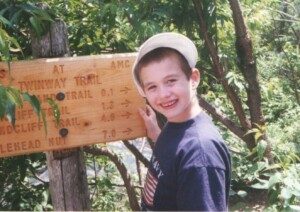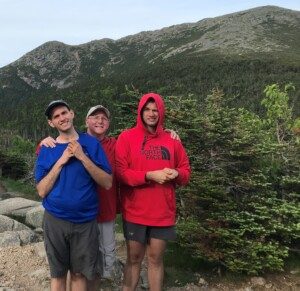Identical twins Jeff and Will have pronounced autism yet could leave most neurotypicals in the dust on mountain hikes. Hiking saved this family!
At age seven they began hiking – and now, at age 28, these handsome twins continue to love the amazing outdoors – especially when they get above treeline (around 4,500 feet)!
But the hiking all began by crazy chance when they were little boys.
Today, their hiking mother, Mary Kae Marinac, explains, “They are highly accomplished hikers, having summited most of the major peaks in New England including the 48 New Hampshire 4,000 Footers, the New England 4Ks (including Vermont and Maine), and other lesser lists (52 With a View, Belknaps 12) — in addition to the Grand Canyon, Utah’s five national parks and in Denali State Park.”
The Mountains Saved Them
Mary Kae explains that a diagnosis of autism “lands like a thud,” but also “these individuals are Uniquely Human, in the words of a book on this community, and their capabilities, and joy in shared experiences like the view above treeline, is universal.”
I myself was diagnosed autistic in spring of 2022. Years ago (when I had no idea I was on the Spectrum) I hiked with a mountain club, climbing 12,000 and 13,000 foot peaks.
So what a joy it is to write about these autistic twins who share my passion for getting to the top of a giant mountain and seeing the world!

Mary Kae with Jeff and Will atop Mt. Abraham in Maine.
“Hiking saved us from autism’s dark side – the feeling that the very word is a lifelong sentence of doom, that your loved-one will never live a ‘normal life, nor will you,” begins Mary Kae.
“It lifted us higher, in every sense. It showed amazing capability within profound disability.”
The twins’ intellectual level, per formal IQ testing, equated to that of a three-year-old. Due to the nature of the IQ evaluation intrument, its accuracy is questionable.
An intellectual challenge is not part of Jeff’s and Will’s autism; it’s a separate disability.
Mary Kae explains that “they speak in limited expressive language in addition to use of alternative-augmented communications software.” The software is TouchChat/AAC, and it supplements or confirms their spoken language as they independently touch the iPad’s pictorial squares.
Mary Kae says that autism has made the entire family stronger. “It proved that our path wasn’t ABA, or floor time, or the new flavor of the month therapy.
“It was my sons’ own unique passion that broke through the thickets of their limitations, up above the trees to stunning vistas, heights we never knew we could reach, and moments of pure joy.”
How the Twins Discovered Hiking
“My family found hiking by accident – after a disastrous day at a farm attempting a normal family outing,” begins Mary Kae.
Every Sunday when the twins were about five and their neurotypical daughter was seven, Mary Kae and her husband, Paul Quirnbach, would try something new, hoping it might “spark a glimmer of a normal interest.”
She explains, “We thought maybe petting the animals might coax them from their interior worlds to prompt language and engagement.
“Unfortunately Will and Jeff hated the smell of goats and donkeys and ducks, and recoiled from petting the sheep. Will bolted 1,000 yards almost onto a busy road in an attempt to get away.
“As the car headed home, Pack Monadnock, a 2,290-foot hump of a mountain, looked down on us like a quiet friend.
“We stopped at the state park at its base since it had bathrooms, then saw hiking trails. Why not, we thought, and started up the 1.4 mile,1000-foot elevation Marion Davis trail.
“Once at the top the kids scrambled up six flights of a fire tower, mesmerized by the views of the Boston skyline to the south, and the ring of big New Hampshire peaks in every direction.
“The next night, they slept solidly for the first time in years, and on Monday teachers asked if I had started new meds, because both boys were calm and attended like they never had. A lightbulb went off. Instead of drugs and therapies, they needed exercise.”

Jeff as a child at a trail junction.
The Wonders of Hiking Exercise for Autistic People
“Turns out exercise does wonders for far more than attending,” says Mary Kae.
“At summits I saw smiles, and joy I never saw anywhere else. Each Sunday we’d pick a new destination with a little bit of elevation gain to make us work, and a view.
“We discovered the boys liked waterfalls and cascading brooks, and I found a book on local nature walks with an index listing trails with waterfalls, rocky scrambles, picnic areas and bathrooms.
“We kept picking successively longer and harder hikes in the book, then graduated to other books.
“Endurance-building took time and patience. We started carrying Meyer-Johnson picture symbol strips showing Hike-Hike-Hike-Snack, then Hike-Hike-Hike-Summit.
“Yet the beaming smiles at the top of each climb were my answer as to whether they liked hiking.”
“Gradually the heavy work of hiking made us stronger and more capable. That included we parents, too. I always struggled with weight maintenance and was inconsistent in my own fitness efforts, as was my husband.
“We started centering vacations around hiking zones, like the Poconos and the White Mountains in New Hampshire and Western Maine.
“We heard of the club for hikers who bag New Hampshire’s 48 tall peaks called the Four Thousand Foot Club, and goaled ourselves to become members.
“After building up to it with lesser peaks, in July 2002 we attempted Mt. Eisenhower, our first 4K.
“It was a sweltering 95-degree day, with 2.8 miles of gradual shaded ascent in the trees, and a final half mile up a tumble of two-foot wide boulders with big gaps in between, and no easy handholds.
“We rested and tried to pace everyone, but after three hours, dehydrated and clammy-sweaty, I wondered if this was too much.
“Yet in 10 minutes we broke out of the trees and a tumble of boulders as the full expanse of Presidential Mountains lie in front of us, rocky spires rising up like soldiers in a line. A wisp of smoke from a cog railway circled them, and an azure sky wrapped us in calm.
“Will turned to me with saucer-wide eyes, flapping his arms in his happy-dance of pure joy.
“I worried about him but just as quickly as he smiled, he charged up the hill, navigating boulder to boulder jumps like he’d done it his whole life, making me hustle to keep close to him.
“In a half hour we arrived at a summit of more than a mountain. We had arrived at ourselves.”
Hiking Improves an Autistic Person’s Coordination
Don’t make the mistake of thinking that coordination is required to go hiking. It’s the other way around: Hiking improves coordination and balance.
Mary Kae explains, “Throughout his school years Jeff’s PT evals said he was at the low end of normal for balance and gait.
“Will, however, had profound motor planning deficits where he struggled to see which foot would climb next, and how to get it there.
“He would hesitate and take twice as long to ascend and even longer to descend. His fear may have been behind some of his drop-to-the ground flops.
“We had to be super-patient, pointing and directing him to specific handholds and where to place his feet.
“The encouragement of their much-loved neurotypical sister often helped power them through tough spots, especially early on.
“It took at least 10 years for him to make significant gains. Today, while he sometimes still takes longer than Jeff to negotiate a challenging segment, he is phenomenally better. Sometimes, when motivated, he’s even faster than Jeff.”
Are you or your child autistic?

Thinking about hiking? What are you waiting for? The mountains are for every body, every neurotype!
“There’s such joy in movement, and in feeling our own bodies take us places,” says Mary Kae. “There is release, from physical aches and pains, but also from the spiritual ones.
“As hikers, when we reach a summit, we throw off the backpacks of our burdens, and all the week’s hassles and irritations fall away, and our bodies get toned for whatever challenges will come the next week.
“The mind-body connection is real – I’ve witnessed it in my own kids and myself.
“When you work your body, all of you – mind, body and spirit – get better. All you need to do is put one foot in front of the other – and tomorrow, take one step more.”
 Lorra Garrick has been covering medical and fitness topics for many years, having written thousands of articles for print magazines and websites, including as a ghostwriter. She’s also a former ACE-certified personal trainer. In 2022 she received a diagnosis of Level 1 Autism Spectrum Disorder.
Lorra Garrick has been covering medical and fitness topics for many years, having written thousands of articles for print magazines and websites, including as a ghostwriter. She’s also a former ACE-certified personal trainer. In 2022 she received a diagnosis of Level 1 Autism Spectrum Disorder.
.
All images copyright Mary Kae Marinac
Autistic Special Interest vs. Neurotypical Hobby: the Difference?
Can Autism Be Ruled Out if the Patient Has Good Eye Contact?
Can Autism Be Ruled Out if the Patient Has Good Eye Contact?



























